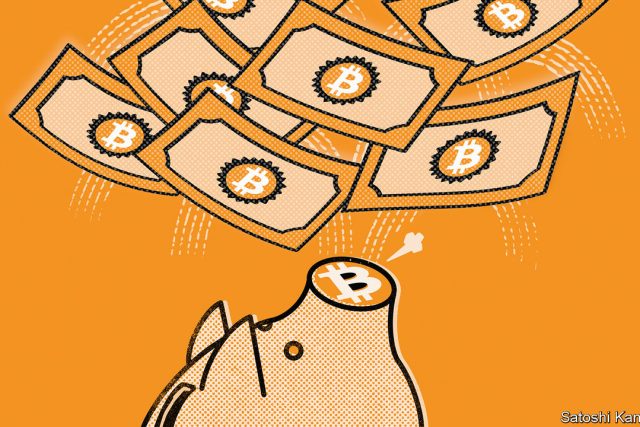The path to approval for the first bitcoin exchange-traded funds (etfs) was long and arduous. Applications appeared before regulators in 2013, when the price of a bitcoin was just shy of $100 and nobody had heard of Sam Bankman-Fried or the phrase “to the Moon”. After a decade of rejection, promoters finally succeeded on January 10th, when the Securities and Exchange Commission (SEC) approved 11 applications for ETFs that track the spot price of bitcoin, which was at the time above $46,000.
The advent of bitcoin ETFs was supposed to be a pivotal moment for the digital asset class. For years, devotees had hoped that such funds would attract strait-laced institutional investors, increase liquidity, and demonstrate the credibility and professionalism of crypto. They had also hoped that their approval might buttress demand for bitcoin, pointing to the precedent of a much older speculative asset. When State Street Global Advisors launched America’s first gold ETF in 2004, the metal fetched less than $500 per ounce, below its price in the early 1980s. Over the years that followed, it soared in value, reaching almost $1,900 per ounce in 2011.
Could the SEC’s blessing fuel a similar long-term rally in bitcoin? So far, the signs are not encouraging. After a steep climb last year, partly in anticipation of regulatory approval for etfs, the price has fallen by 7% since the sec gave the go-ahead. Inflows into ETFs launched by firms such as BlackRock, Fidelity and VanEck have been almost entirely offset by outflows from the Grayscale Bitcoin Trust, an investment vehicle that also became an ETF on January 11th.
Other factors helped drive gold’s surge in the late 2000s. The final prohibitions on bullion ownership in China were also lifted in 2004. As a result, the country’s demand for physical gold rose from 7% of the world total in 2003 to 26% a decade later. The slide in global interest rates over the same period helped, too. An asset with no yield becomes more appealing in a world where little else offers a meaningful yield either.
Despite the metal’s reputation as a store of value, when the first gold ETFs were launched the market was still dominated by jewellery, rather than investment. The new funds thus helped turn a largely physical asset into a liquid financial one. By contrast bitcoin is already a financial asset. Unlike gold, there is no use for digital currencies in the physical world. Although it will now become a little easier to gain exposure to bitcoin, it is already more readily available to investors than gold was in 2004. Whereas punters buying the metal had to consider options for delivery and storage, bitcoin is available via mainstream brokers such as Robinhood and Interactive Brokers.
A different set of ETFs provide a less optimistic precedent for bitcoin. In 2022 Itzhak Ben-David, Francesco Franzoni, Byungwook Kim and Rabih Moussawi, four academics, published research suggesting that thematic equity ETFs, which attempt to track a narrow industry or trend, underperform broader ETFs by about a third over the five years after their launch. That is because of a straightforward problem: when thematic ETFs get going, the buzz around the investment is already extensive and the underlying assets are already pricey.
To issuers, such hype is a feature not a bug. etfs that track broad market indices are the supermarkets of the investing world. Issuers compete with one another on fees, compressing margins to almost nothing in pursuit of enormous volumes. Some of the largest ETFs that track big equity indices make just 30 cents a year for every $1,000 invested. In contrast, more unusual offerings give providers an opportunity to charge higher fees. The more hype surrounding a given sector, the greater the inflows—and the greater the fees available.
Research published by Purpose Investments, an asset manager, finds that the lion’s share of inflows to thematic ETFs tends to come when the assets are at their most expensive. When the underlying stocks are relatively cheap, investors tend to pull out their money. As Craig Basinger of Purpose puts it, a buy-high, sell-low strategy is unlikely to be a winning one for investors.
etfs are not, therefore, a magic trick that boosts the price of the assets. Indeed, in many cases the funds turn out to be the exact opposite: a way to generate hype and long-run underperformance. Crypto bulls who had hoped that the advent of bitcoin ETFs would offer the asset an extended lift may, in fact, face extended disappointment. ■
Read more from Buttonwood, our columnist on financial markets:
Investors may be getting the Federal Reserve wrong, again (Jan 24th)
Wall Street is praying firms will start going public again (Jan 18th)
Bill Ackman provides a lesson in activist investing (Jan 11th)
Also: How the Buttonwood column got its name




The Most Read
Сryptocurrencies
Bitcoin and Altcoins Trading Near Make-or-Break Levels
Financial crimes
Thieves targeted crypto execs and threatened their families in wide-ranging scheme
Financial crimes
Visa Warning: Hackers Ramp Up Card Stealing Attacks At Gas Stations
News
Capitalism is having an identity crisis – but it is still the best system
Uncategorized
The 73-year-old Vietnamese refugee is responsible for bringing Sriracha to American consumers
Uncategorized
Electric Truckmaker Rivian, Backed By Amazon, Ford, Raises Whopping $1.3 Billion